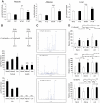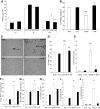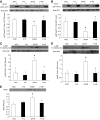Transgenic restoration of long-chain n-3 fatty acids in insulin target tissues improves resolution capacity and alleviates obesity-linked inflammation and insulin resistance in high-fat-fed mice
- PMID: 20841610
- PMCID: PMC2992767
- DOI: 10.2337/db10-0054
Transgenic restoration of long-chain n-3 fatty acids in insulin target tissues improves resolution capacity and alleviates obesity-linked inflammation and insulin resistance in high-fat-fed mice
Abstract
Objective: The catabasis of inflammation is an active process directed by n-3 derived pro-resolving lipid mediators. We aimed to determine whether high-fat (HF) diet-induced n-3 deficiency compromises the resolution capacity of obese mice and thereby contributes to obesity-linked inflammation and insulin resistance.
Research design and methods: We used transgenic expression of the fat-1 n-3 fatty acid desaturase from C. elegans to endogenously restore n-3 fatty acids in HF-fed mice. After 8 weeks on HF or chow diets, wild-type and fat-1 transgenic mice were subjected to insulin and glucose tolerance tests and a resolution assay was performed. Metabolic tissues were then harvested for biochemical analyses.
Results: We report that the n-3 docosanoid resolution mediator protectin D1 is lacking in muscle and adipose tissue of HF-fed wild-type mice. Accordingly, HF-fed wild-type mice have an impaired capacity to resolve an acute inflammatory response and display elevated adipose macrophage accrual and chemokine/cytokine expression. This is associated with insulin resistance and higher activation of iNOS and JNK in muscle and liver. These defects are reversed in HF-fed fat-1 mice, in which the biosynthesis of this important n-3 docosanoid resolution mediator is improved. Importantly, transgenic restoration of n-3 fatty acids prevented obesity-linked inflammation and insulin resistance in HF-fed mice without altering food intake, weight gain, or adiposity.
Conclusions: We conclude that inefficient biosynthesis of n-3 resolution mediators in muscle and adipose tissue contributes to the maintenance of chronic inflammation in obesity and that these novel lipids offer exciting potential for the treatment of insulin resistance and diabetes.
Figures




Similar articles
-
A high ratio of dietary n-3/n-6 polyunsaturated fatty acids improves obesity-linked inflammation and insulin resistance through suppressing activation of TLR4 in SD rats.Nutr Res. 2013 Oct;33(10):849-58. doi: 10.1016/j.nutres.2013.07.004. Epub 2013 Aug 9. Nutr Res. 2013. PMID: 24074743
-
Adipose tissue inflammation induced by high-fat diet in obese diabetic mice is prevented by n-3 polyunsaturated fatty acids.Diabetologia. 2006 Sep;49(9):2109-19. doi: 10.1007/s00125-006-0300-x. Epub 2006 Jun 17. Diabetologia. 2006. PMID: 16783472
-
Metabolic and immunomodulatory effects of n-3 fatty acids are different in mesenteric and epididymal adipose tissue of diet-induced obese mice.Am J Physiol Endocrinol Metab. 2013 Jun 1;304(11):E1140-56. doi: 10.1152/ajpendo.00171.2012. Epub 2013 Mar 12. Am J Physiol Endocrinol Metab. 2013. PMID: 23482450
-
Omega-3 fatty acids and adipose tissue biology.Mol Aspects Med. 2018 Dec;64:147-160. doi: 10.1016/j.mam.2018.01.004. Epub 2018 Jan 17. Mol Aspects Med. 2018. PMID: 29329795 Review.
-
The Nematode Caenorhabditis elegans as a Model Organism to Study Metabolic Effects of ω-3 Polyunsaturated Fatty Acids in Obesity.Adv Nutr. 2019 Jan 1;10(1):165-178. doi: 10.1093/advances/nmy059. Adv Nutr. 2019. PMID: 30689684 Free PMC article. Review.
Cited by
-
Synergistic induction of lipid catabolism and anti-inflammatory lipids in white fat of dietary obese mice in response to calorie restriction and n-3 fatty acids.Diabetologia. 2011 Oct;54(10):2626-38. doi: 10.1007/s00125-011-2233-2. Epub 2011 Jul 21. Diabetologia. 2011. PMID: 21779874
-
Maternal Diet Supplementation with n-6/n-3 Essential Fatty Acids in a 1.2 : 1.0 Ratio Attenuates Metabolic Dysfunction in MSG-Induced Obese Mice.Int J Endocrinol. 2016;2016:9242319. doi: 10.1155/2016/9242319. Epub 2016 Dec 5. Int J Endocrinol. 2016. PMID: 28050167 Free PMC article.
-
Stress-Induced Production of Bioactive Oxylipins in Marine Microalgae.Mar Drugs. 2024 Sep 4;22(9):406. doi: 10.3390/md22090406. Mar Drugs. 2024. PMID: 39330287 Free PMC article.
-
Specific lipid mediator signatures of human phagocytes: microparticles stimulate macrophage efferocytosis and pro-resolving mediators.Blood. 2012 Oct 11;120(15):e60-72. doi: 10.1182/blood-2012-04-423525. Epub 2012 Aug 17. Blood. 2012. PMID: 22904297 Free PMC article.
-
Role and mechanism of specialized pro-resolving mediators in obesity-associated insulin resistance.Lipids Health Dis. 2024 Jul 30;23(1):234. doi: 10.1186/s12944-024-02207-9. Lipids Health Dis. 2024. PMID: 39080624 Free PMC article. Review.
References
-
- White PJ, Marette A: Inflammation-induced insulin resistance in obesity: When immunity affects metabolic control. In Physical activity and type 2 diabetes Therapeutic effects and mechanisms of action. Hawley JA, Zierath JR. Eds. Champaign, IL, Human Kinetics Publishers, 2008, p. 83–104
-
- Hotamisligil GS: Inflammation and metabolic disorders. Nature 2006;444:860–867 - PubMed
-
- Serhan CN: Resolution phase of inflammation: novel endogenous anti-inflammatory and proresolving lipid mediators and pathways. Annu Rev Immunol 2007;25:101–137 - PubMed
-
- Simopoulos AP: Evolutionary aspects of diet, essential fatty acids and cardiovascular disease. Eur Heart J 2001;3(Suppl. D):D8–D21 - PubMed
Publication types
MeSH terms
Substances
Grants and funding
LinkOut - more resources
Full Text Sources
Medical
Molecular Biology Databases
Research Materials
Miscellaneous

